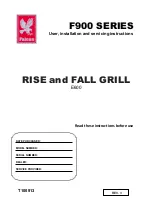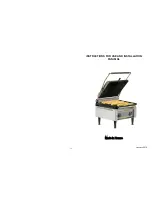
ORIGINAL INSTRUCTIONS
11
GB
Before attempting to use the tool, read all
instructions and keep for further reference.
NOTE!
Read all instructions below
.
Failure to
comply with them can lead to electrical shock,
fi re or personal injury. The defi nition of “pneu-
matic tool”, which is used in the instructions, re-
fers to all tools, which are driven by an air com-
pressed stream at the appropriate pressure.
COMPLY WITH THE FOLLOWING IN-
STRUCTIONS
General safety rules
Before starting to install, work, repair, maintain
or change accessories, or while working near
a pneumatic tool due to many hazards, it’s
necessary to read and understand the safe-
ty instructions. If the above mentioned steps
are not taken, it may result in serious injury.
The installation, assembling or adjustment of
pneumatic tools may only be performed by
qualifi ed and trained staff . Do not modify the
pneumatic tool. Modifi cations can reduce the
effi ciency and level of safety, and increase the
risk for a tool operator. Do not dispose of safe-
ty instructions, but forward it to the tool opera-
tor. Do not use the pneumatic tool if it is dam-
aged. The tool should be subject to periodic
inspections for visibility of the data required
by ISO 11148. The employer / user should
contact the manufacturer for replacement of a
rating plate whenever it is necessary.
Hazards associated with disposed parts.
Disconnect the tool from the power supply
before changing the insertion tool or acces-
sory. The damage to the workpiece, acces-
sories or even the inserted tool can cause
the ejection of parts at high speed. Always
wear eye protection (goggles) - resistant to
impact. Degree of protection should be se-
lected depending on the work that needs to
be done. While working with the tool over
your head, use a protective helmet. You
should also take into account the risk to by-
standers. Make sure that the workpiece is
securely fastened. Do not work with the tool
without ensuring that, the insertion tool stop
has been installed. To avoid injury, replace
the stop when it is worn, cracked or distort-
ed. Securely apply the insertion tool into the
work surface before starting work.
Hazards associated with the work.
Using the tool can expose the operator’s
hands to hazards such as: crushing, impact,
cutting, abrasion and heat. It’s necessary to
wear the appropriate gloves to protect the
hands. The tool operator and maintenance
personnel should be physically able to cope
with the quantity of the tools and their power.
Hold the tool properly. Keep balance and to
ensure the safe feet positioning. It’s neces-
sary to relase the pressure on the start and
stop device in the case of interruption in the
power supply. Use only the lubricants, which
are recommended by the manufacturer. Avoid
direct contact with the insertion tool during or
immediately after work, cause it may be hot.
Wear protective goggles, it’s recommended to
use tight gloves and protective clothing.
Hazards associated with repetitive movements
Using a pneumatic tool while work associ-
ated with repetitive movements, the oper-
ator is exposed to the discomfort of hands,
arms, shoulders, neck or other parts of the
body. While using the pneumatic tool, the
operator should take a comfortable posture
for correct feet positioning and should avoid
postures, which are strange or not providing
the balance. The operator should change
his posture during long work, it will help to
avoid discomfort and fatigue. If the operator
experiences symptoms such as: permanent
or repeated discomfort, pain, throbbing pain,
tingling, numbness, burning or stiff nes -. He
should not ignore them, he should inform the
employer and consult a doctor.
Hazards associated with accessories
Disconnect the tool from the power supply
before changing the insertion tool or acces-
sory. Use accessories and consumables
only in sizes and types recommended by
the manufacturer. In case of the hammers,
if applicable, never use any chisels as hand
tools. It have been specially designed and
heat-treated for use only in non-rotating
impact tools. In case of the hammers and
crushers, never use blunt chisels, as appli-
cable, because they are subjected to heavy
loads and may break due to material fatigue.
Using a blunt tool can increase vibrations
and therefore sharpened tools should always
be used. In case of the hammers, as appli-
cable, never cool hot insertion tools in water,
this may result in brittleness and premature
wear. In case of the hammers, as applicable,
damage or breakage of the tool may result
from improper use of the tool as a lever, for
example while lifting. It’s better to work by
removing smaller fragments to avoid jams.
Содержание VOREL 81122
Страница 88: ...INSTRUKCJA ORYGINALNA 88 ...












































